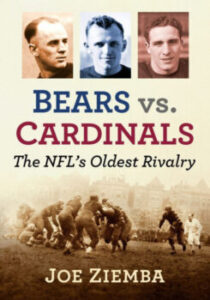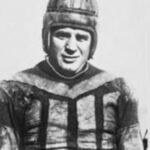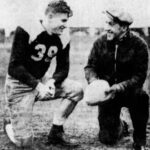Any time a city loses a sports team franchise, it initiates years of debate regarding why such a thing could have possibly occurred. Recent NFL teams have moved from cities such as St. Louis, Oakland, and Los Angeles. Usually, there is an obvious reason for the departure, whether it is low fan attendance or simply a better offer from the new host location. But always-always-the departing club will leave behind some bad memories and hard feelings with its forgotten fans left simply to wonder WHY?
Sixty-one years ago this month the Chicago Cardinals, the NFL’s oldest franchise,suddenly pulled up its roots and left for St. Louis. Certainly, there had been rumors in the past that the team would leave the city at some time in the future. In fact, these rumors had swirled for decades, with possible destinations being Atlanta, Buffalo, Dallas, or even San Francisco. But fans of the team, located on the south side of the windy city, were always comforted by the reassuring words of its owners that such a desertion would never, ever happen.
Chicago Cardinals Move to St. Louis?
That is why on March 9, 1960, Cardinals’ fans were stunned by the rumors that the team would soon be departing for a new home in St. Louis. After being around the south side of Chicago since 1899, the team had established a solid presence in the National Football League. Despite a woeful 2-10 mark in 1959 which included a move of its home games to Soldier Field as well as a hosting a pair of “home” games in Minneapolis, supporters of the club were not overly concerned that a departure from the city would be imminent.
There had been similar rumors in the past and Cardinals’ Business Manager Arch Wolfe was quick to denounce the latest rumors on March 10 stating: “That story has been cropping up for some time. As far as I know there is nothing to it.” Later, team Managing Director Walter Wolfner added: “There is not a grain of truth” to the rumor. “Someone is always trying to move us some place. Some time ago we were approached by a St. Louis group. We talked but nothing came of it. We’ve been approached by many people but we’re still the Chicago Cardinals.” Was there still hope 61 years ago today that the Cardinals would remain in Chicago?
Playboy or Jack Brickhouse?
Chicagoans awakening on Saturday, March 12, 1960 and perhaps shaking off the effects of a long night fraternizing with a few quarts of Drewrys beer, enjoyed two nice choices on mid-day television. On Channel 7 at 11:30 am, one could watch “Playboy’s Penthouse” with guests such as Sammy Cahn, Frances Faye, and the entertaining Marty Rubenstein Trio. Over on Channel 9, football fans could view a new NFL program during the off-season that would focus on one of the more exciting games from the previous (1959) season.
Local announcer Jack Brickhouse would host the program which would debut with a recap on the recent match-up between the Cardinals and the Eagles. Unfortunately, Cardinals’ fans feared that this would be the last opportunity for them to watch their beloved south side gridders.
Two thousand miles west, the winter NFL meetings were on going in Los Angeles with additional rumors emerging regarding the proposed move of the Cardinals to St. Louis. On March 12, the St. Louis Post-Dispatch reported that Joe Griesedieck, the president of Falstaff Brewing Company in St. Louis, had just procured a minority ownership share of the Cardinals. Surely this would signify the imminent transfer of the franchise to St. Louis? Or was it a way for the current ownership to attract some much needed financial support?
However, Managing Director Walter Wolfner of the Cardinals continued to brush off such queries, indicating that Griesedieck’s interest in the club had “nothing whatsoever to do with any contemplated moves we might make.” He also denied that George Halas, owner of the Chicago Bears, had offered monetary incentives for the Cardinals to move out of Chicago where both teams were crippled at the time by television blackouts.
Regarding the purported Halas offer, Wolfner stated that: “Any stories to that effect are untrue.” So, as of March 12, 1960, the Cardinals were still part of the Chicago landscape. However, there was still one more day of NFL meetings remaining in Los Angeles…
In the midst of the strange handling by the Cards’ management of the perceived move by the Cardinals to St. Louis 61 years ago, Managing Director Walter Wolfner took the opportunity while in the media spotlight to issue one more bizarre statement.
While continuing to deny that the Cardinals would move to St. Louis, Wolfner, for some reason, decided to throw Cardinals’ coach Pop Ivy under the proverbial bus for a trade completed over a year earlier. On March 3, 1959, the Cardinals traded future Hall-of-Famer Ollie Matson to the Rams for an astounding nine players!
The exchange was engineered by then Rams’ general manager Pete Rozelle and certainly grabbed the attention of the NFL universe. Although in the long run neither team benefited much from the massive trade since both clubs finished 2-10 in 1959, Wolfner eased away from the “move” rumors to suddenly criticize the Matson trade to the Los Angeles Times on March 13, 1960: “I went along with the coach [Pop Ivy] but I’d never make the trade on my own. The Rams definitely got the best of the deal.” Huh? And to make this comment a year later?
As Wolfner continued to feint and dodge around the persistent “move” rumors, he once again embarrassed the proud franchise with another confusing, chaotic, and unnecessary statement. And yet for the loyal fan base who were simply seeking some answers, the worst was yet to come…
This Is Great News For St. Louis
And so it was that finally, on March 13, 1960, the Chicago Cardinals decided to take advantage of some attractive financial enticements and leave the south side of Chicago for the uncertain environs of St. Louis. The St. Louis Post-Dispatch proclaimed: “The Chicago Cardinals, oldest club in the National Football League, were on their way to St. Louis today with only a few minor conditions remaining to be fulfilled.”
The Cards looked forward to playing soon in a possible new 53,000 seat riverfront stadium. Until then, the Cardinals would line up initially in cozy Sportsman’s Park. “This is good news for St. Louis,” exclaimed August Busch, the president of the St. Louis baseball Cardinals. “The football Cardinals will give our city a year-round program of high-quality sports,” Busch told the St. Louis Post-Dispatch.
While Chicago Cardinals’ fans had feared this final announcement, it likely caught a few journalists by surprise due to the ever-present denials by Walter Wolfner during the preceding week. The Tampa (FL) Times noted: “The shift of the Cards to St. Louis, announced by commissioner Pete Rozelle, came as a surprise. The day before, managing director Walter Wolfner had denied that such a widely rumored move was contemplated.”
In fact, the Times continued, “Wolfner assured the press that he did not contemplate a move of the club and emphasized that such a thing would not happen in 1960. It would cost too much to move, he said, and ‘such a move is not necessary.'”
In the end, Wolfner succumbed to the lure of a monster $500,000 pay day from the NFL for “moving” expenses. The Times added: “A large part of it, Rozelle disclosed, was underwritten by the rival Chicago Bears.” The “donation” was well worth it to the Bears and owner George Halas, since it would allow just one team to enjoy the previously blacked out and rapidly expanding Chicago television market.
With both teams previously playing almost every Sunday in Chicago, the rules at the time prohibited, or blacked out, the televising of any road games back to Chicago. Pittsburgh Steelers’ president Art Rooney praised the move by stating: “The league never enjoyed any television revenue from Chicago games during the years the Cardinals played there. From now on, the Chicago situation will be the same as it is elsewhere in the league,” he told the St. Louis Post-Dispatch.
So–while the NFL owners happily congratulated one another on the opening of another revenue stream for themselves, the tidal wave of praise for the “move” swept over perhaps the most important segment of this transaction: the Chicago Cardinals’ fans. They were ignored, forgotten, and excluded from any part of the process…which, of course, is not unusual whenever an event of this type occurs.
Still, fans simply wanted to know why? Why did the Cardinals leave? Did George Halas push them out? Did the NFL force the move?
Many theories have been exchanged over the years, but the two main reasons for the move were basically poor attendance and the TV black out issue in Chicago. In the late 50s, several home games for the Cardinals drew less than 20,000 fans. The only team to attract a decent crowd was the Chicago Bears and the north siders visited Comiskey Park just once a year.
Less attendees equals financial issues and the Cardinals were now facing that issue. With television revenue picking up, the fact that neither the Bears nor the Cardinals could televise their away games back home was a distinct disadvantage, but specific to the only city in the league at the time with two NFL teams.
I was fortunate to interview the late Cardinals owner William Bidwill years ago and asked him about the reason for the move. His answer was short and precise. He said: “Basically, it was because of television. It wasn’t necessarily a move to anywhere, but a move out of Chicago because of the television problems.”
For the inconvenience, the Cardinals were presented with $500,000 to help cover expenses associated with the move as well as pay off some lingering debt from the remodeling of Soldier Field in 1959. As mentioned, George Halas contributed wholeheartedly to the Cardinals moving fund!
The Chicago Tribune summarized the reasoning behind ‘The Move’ stating: “The move not only will leave the Bears as the only professional team in the nation’s third largest market, but it opens up that territory to television. In the past, when either the Cardinals or the Bears were at home, the Chicago area was blacked out. The Bears will now be able to televise their road games back to Chicago…Walter Wolfner contended the purpose ‘was to open up Chicago for TV.’
He made no mention of the visiting owners who resented accepting checks only for the flat guarantee in Chicago in exchange for checks well over the guarantee figure when the Cardinals played on the road.”
And so the Cardinals left for St. Louis in March of 1960, never to return. What about their thousands of loyal fans? Many blamed Halas for the departure and they and their descendants have vowed never to cheer for the Bears. Others patiently followed the Cardinals wherever they might be. Still, a smaller portion switched their allegiance to Green Bay, while a majority eventually accepted the presence of the Chicago Bears.
There is one more story to share regarding the loss of the Cardinals. When their move to St. Louis was announced, their former landlord, Bill Veeck of the Chicago White Sox, was determined to bring another professional football club to Comiskey Park. Veeck attempted to secure a franchise in the new American Football League, but was unsuccessful in his efforts, leaving the Bears as the only representative of the pro football wars remaining in Chicago. And that has never changed…
Thank you for listening to this episode of “When Football Was Football” on the Sports History Network. Please join us next time for the strange, but true, tale of when Green Bay came to Chicago for the first time. It was a clash of cultures both on the field and in the streets!
Joe Ziemba is the host of this show, and he is an author of early football history in the city of Chicago.
Here, you can learn more about Joe and When Football Was Football, including all of the episodes of the podcast.
Interested in more from host Joe Ziemba? You can see him on the other side of the mic as a guest on The Football History Dude podcast talking about the history of the Chicago Cardinals and his book When Football Was Football.
Resources
Please Note – As an Amazon Associate I earn from qualifying purchases
More From When Football Was Football
Ugly Passers, Brick Walls, and Feisty Cardinals
Since the Arizona Cardinals are the NFL’s oldest team, with...
Read MoreThe NFL’s Forgotten Gold Medalist!
As usual during the staging of the Summer Olympics, numerous...
Read MorePaddy Driscoll’s Almost Perfect Season
Back at the beginning of the National Football League in...
Read More120,000 Fans Witness High School Football Game in 1937!!!
Let’s set the stage… It was a warm November afternoon...
Read More



